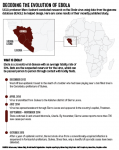The rise of advanced genetic computing technology has transformed how we study evolution.
Broad-platform Evolutionary Analysis General Likelihood Evaluator, a public evolutionary statistics library, allows researchers worldwide to collaborate on public health projects and clinical research at the intersection of biostatistics and evolutionary biology. Marc Suchard, a UCLA professor of biomathematics, biostatistics and human genetics, has used BEAGLE to study everything from woolly mammoths to the Ebola virus epidemic.
Suchard began coding BEAGLE in 2007 as a statistical tool to calculate probabilities on genetic sequences across the tree of life. Suchard’s team designed the program on graphics processing units normally used to enhance graphics speed in computer games, he said.
Suchard said BEAGLE performs many easy operations at the same time to reach an extremely high and efficient level of computing.
“Up until this point, everyone in the evolutionary science world had to write their own calculator,” Suchard said. “Results were very mixed.”
BEAGLE’s current version can crunch a year’s worth of computational work in a couple of days. Scientists can draw on BEAGLE’s interface to conduct their own research projects with software such as PhyML and GARLI. Using BEAGLE, 93 scientists from 16 countries published a paper about Ebola this month in Nature.
Suchard also helped create multiple supplemental programs for BEAGLE, such as Bayesian Evolutionary Analysis Sampling Trees to compute the probabilities of multiple molecular evolution pathways.
Suchard said he and his research group used BEAST and other phylogenetic programs in conjunction with BEAGLE to investigate the origin and spread of the West African Ebola epidemic. On the ground, virologists collected Ebola samples from 1,610 patients using nanopore sequencing, a novel genome sequencing technology performed using a handheld MinION device that can sequence an entire strand of DNA in ten minutes.
The researchers fused genomics with demographic factors to understand how the virus proliferated, which informed approaches to public health interventions, Suchard said. The studies produced colorful graphs and a YouTube video of how Ebola evolved and spread throughout Guinea, Sierra Leone and Liberia.
Evolutionary statistics programs also hold clinical importance for researchers like Christina Ramirez, a professor of biostatistics at the UCLA Fielding School of Public Health, who specializes in the molecular evolution of HIV. Ramirez began collaborating with Suchard around 2003.
HIV is a particularly challenging virus to study since it constantly mutates the proteins on its envelope to evade detection by the host immune system, Ramirez said. Human cells exhibit surface receptors and coreceptors, such as CXCR4, that widely recognize and welcome HIV into their interiors to induce infection.
Ramirez and Suchard jointly studied how HIV evolved with coreceptors in response to antiretroviral drug therapy. The team used BEAST to simulate treatment cycles in which the patient went on and off the drug. The International AIDS Society cited their results in an annual report of treatment recommendations.
Ramirez said statistical technology, such as BEAGLE and BEAST, could potentially yield clinically relevant results from complex datasets and help create successful drugs and treatments for HIV.
“Thirty years ago, when you found out you had AIDS, you had a year to get your affairs in order and then you died,” Ramirez said. “Now, I have hope.”
BEAGLE, BEAST and other phylogenetic software also contribute to the work of evolutionary biologists.
Suchard uses the programs to study the evolution of ancient North American megafauna. Last month, he copublished a study about American bison that suggested the animal’s most recent common ancestor emerged during an ice age. In a 2011 study, he developed a phylogeographic model to claim the polar bear originated in modern-day Ireland.
Suchard said he is not done improving BEAGLE or coding supplemental software. Next month, he will travel to Scotland to discuss improvements to the program with his original research partners. Afterward, he will study how the Zika virus is spreading across the Caribbean, and its points of entry into North America, he said.
“What’s rewarding is being able to work on math and probability problems that both perk my curiosity and have an impact on public health,” Suchard said.
